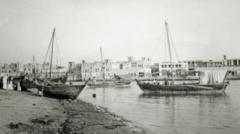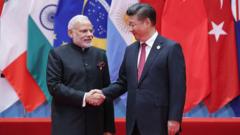Not long ago, a fascinating narrative surfaced about the historical nexus between the Gulf states and British India, revealing how close places like Dubai came to becoming part of India.
When Dubai Almost Became Part of India: A Historical Reflection

When Dubai Almost Became Part of India: A Historical Reflection
In a striking account, David Holden recounts how British India’s legacy once extended to the Arabian Peninsula, raising questions about geopolitical identities.
In the winter of 1956, The Times correspondent David Holden found himself documenting life in Bahrain, then a British protectorate. What began as a geographical assignment quickly morphed into an exploration of an extraordinary past as he traversed regions like Dubai and Abu Dhabi, which were steeped in the remnants of British India. Holden noted, “The Raj maintains here a slightly phantasmal sway,” highlighting how British customs permeated everyday life even in far-flung areas. The echoes of an era when Indian servitude defined social hierarchy were palpable, as he observed that “the servants are all bearers, the laundryman a dhobi,” and even the local cuisines were influenced by British-Indian traditions.
During this time, Oman’s Sultan entertained conversations rooted in Indian culture, fluency in Urdu being a testament to these ties, while military uniforms harked back to India’s colonial period. As Holden emphasized, “One had an extraordinarily powerful impression that all the clocks here had stopped seventy years ago,” perfectly encapsulating the persisting British influence in these Gulf regions.
Most notably, by the early 20th century, a significant portion of the Arabian Peninsula was integrated into the British Indian Empire as protectorates, governed from Delhi and answerable to the Viceroy. Under the Interpretation Act of 1889, these territories were legally deemed part of India, illustrating an overlooked complexity in the colonial narrative. While Indian passports were issued as far as Aden, signaling an administrative extension, the political dynamics were about to change.
The 1920s heralded a shift to Indian nationalism, pushing non-colonial perspectives forward as the borders began to be redefined. A decision from King George VI in 1937 marked Aden’s separation from India, thus beginning a wider fragmentation of British territories. Although the region remained administratively connected to India until 1947, the impending partitions of British territories hinted at future changes.
By the time of India and Pakistan's independence, the Gulf states were quietly omitted from the merger of princely states, as bureaucratic indifference led to their continued detachment from Indian governance. British Prime Minister Clement Attlee’s propositions for a synchronized withdrawal from India and the Gulf were overridden, allowing British influence to linger until 1971, long after the formal dissolution of the British Empire.
In the aftermath of colonialism, the Gulf nations emerged, creating narratives that distanced themselves from their India-linked past. The myth of an ancient sovereignty has reinforced their modern identities. Meanwhile, personal remembrances exist, reflecting the class dynamics that once defined the region.
Today, vibrant and flourishing, Dubai stands as an economic powerhouse while its historical ties to British India are often overlooked. The bureaucratic distinction that alienated these regions from India’s control has deeply shaped the socio-political landscape, leaving only faint echoes of India's significant potential legacy in the Gulf.
Sam Dalrymple reflects on these layered histories in his work, “Shattered Lands: Five Partitions and the Making of Modern Asia,” as the complex tapestry of colonial legacies continues to resonate.
During this time, Oman’s Sultan entertained conversations rooted in Indian culture, fluency in Urdu being a testament to these ties, while military uniforms harked back to India’s colonial period. As Holden emphasized, “One had an extraordinarily powerful impression that all the clocks here had stopped seventy years ago,” perfectly encapsulating the persisting British influence in these Gulf regions.
Most notably, by the early 20th century, a significant portion of the Arabian Peninsula was integrated into the British Indian Empire as protectorates, governed from Delhi and answerable to the Viceroy. Under the Interpretation Act of 1889, these territories were legally deemed part of India, illustrating an overlooked complexity in the colonial narrative. While Indian passports were issued as far as Aden, signaling an administrative extension, the political dynamics were about to change.
The 1920s heralded a shift to Indian nationalism, pushing non-colonial perspectives forward as the borders began to be redefined. A decision from King George VI in 1937 marked Aden’s separation from India, thus beginning a wider fragmentation of British territories. Although the region remained administratively connected to India until 1947, the impending partitions of British territories hinted at future changes.
By the time of India and Pakistan's independence, the Gulf states were quietly omitted from the merger of princely states, as bureaucratic indifference led to their continued detachment from Indian governance. British Prime Minister Clement Attlee’s propositions for a synchronized withdrawal from India and the Gulf were overridden, allowing British influence to linger until 1971, long after the formal dissolution of the British Empire.
In the aftermath of colonialism, the Gulf nations emerged, creating narratives that distanced themselves from their India-linked past. The myth of an ancient sovereignty has reinforced their modern identities. Meanwhile, personal remembrances exist, reflecting the class dynamics that once defined the region.
Today, vibrant and flourishing, Dubai stands as an economic powerhouse while its historical ties to British India are often overlooked. The bureaucratic distinction that alienated these regions from India’s control has deeply shaped the socio-political landscape, leaving only faint echoes of India's significant potential legacy in the Gulf.
Sam Dalrymple reflects on these layered histories in his work, “Shattered Lands: Five Partitions and the Making of Modern Asia,” as the complex tapestry of colonial legacies continues to resonate.




















